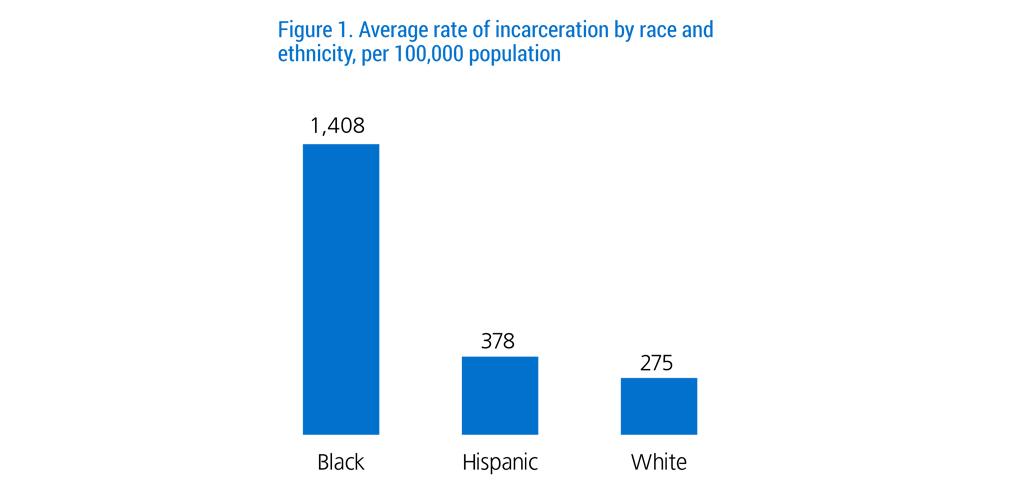
These days, the issue of criminal justice reform is rarely talked about without also recognizing and discussing the overarching problem of racial disparity in the United States justice system. According to a report created by the Sentencing Project, an advocacy center working to solve this issue, African Americans are more likely than white Americans to be arrested; once arrested, they are more likely to be convicted; and once convicted, and they are more likely to experience lengthy prison sentences. African-American adults are 5.9 times as likely to be incarcerated than whites and Hispanics are 3.1 times as likely. As of 2001, one of every three black boys born in that year could expect to go to prison in his lifetime, as could one of every six Latinos—compared to one of every seventeen white boys. The largest overarching statistic is that today, people of color represent 37% of the American population but 67% of the prison population.
These huge differences are a result of decades of systemic opression and racial discrimination. This has led many to claim that our criminal justice system is not fair and uniform, rather there seem to be two systems: one for the wealthy, and one for the poor and people of color. In fact, the purporting of the message that the system is fair could even be dangerous. As Georgetown professor David Cole states, “The formal fairness obscures the systemic concerns that ought to be raised by the fact that the prison population is overwhelmingly poor and disproportionately black.” Therefore, I think it is important this week to analyze why this problem exists, the magnitude of the problem, and what we can do to help mitigtate the effects of racial discrimination in the justice system.
To begin, the disproportionate rate of mass incarceration of African Americans is largely due to larger levels of police contact with this demographic than any other. Essentially, due to a combination of implicit bias as well as media portrayal, and disastrous policing policies historically instituted to target African Americans, officers have much higher contact with this group, leading to more arrests and more unrest. With regards to bias and media portrayal, many seem to assume that African Americans commit these crimes more than other races when in reality they are committed at the same or similar levels. This leads to police targeting minority neighborhoods more prevalently because that is where the crime is believed to take place, leading to misdemeanor charges that induce a violent cycle of prolonged and repeated incarceration. Also, over the years many harmful policies such as Stop and Frisk, Broken Windows, and those instituted during the “War on Drugs” specifically targeted and caused greater interaction with African Americans. Some of these policies, initially created to help maintain order, have been proven to not be effective and instead, with the increased interaction it brings the possibility of violence between officers and citizens, resulting in what we see far too often: unarmed African Americans being killed by officers. This damages the community, increases tension between these two groups, and ultimately results in the mass incarceration of this demographic as a form of retribution and abuse of power.
Another component to this issue is what’s known as “pretrial.” In 2016, African Americans were first detained in local jails at 3.5 times the rate of non-hispanic white Americans. This detention has been shown to increase the probability of a conviction and detainees awaiting trial are more likely to accept a unfavorable plea deal, be sentenced to prison, or given a longer sentence. The only way to avoid this detention is to get released with a money bond, which is a large hurdle for lower-income defendants.
Finally, the largest component to talk about is sentencing. While I talked extensively about mandatory minimum sentencing in a previous post, it represents only a fraction of the many errors and harmful aspects related to the current state of sentencing. Primarily, the justice system is too eager to impose lengthy sentences, which have been shown time and time again to not be effective. This is because most people seem to “age out” of crime. This has been shown as recidivism rates, or the likelihood of previously convicted people to reoffend, decrease with age and crime drops sharply after adults reach their 30s and 40s. Therefore, shutting off members of communities who could possibly be ready to reintegrate and contribute to society only hinders everyone in the long run. Next, we need to reduce the targeting and criminalization of youth. The psychological effects of juvenile detention severely impact young Americans and this issue needs to be remedied as well.
Lastly, we need to work together as a society to help remove the implicit biases against people of color to change the minds of judges, jurors, and prosecutors. In doing so, I beleive we can reform the sentencing system to truly uphold justice for all, equally.

Li, Weihua. “The Growing Racial Disparity in Prison Time.” The Marshall Project, The Marshall Project, 3 Dec. 2019, www.themarshallproject.org/2019/12/03/the-growing-racial-disparity-in-prison-time.
“Report of The Sentencing Project to the United Nations Special Rapporteur on Contemporary Forms of Racism, Racial Discrimination, Xenophobia, and Related Intolerance Regarding Racial Disparities in the United States Criminal Justice System.” The Sentencing Project, 19 Apr. 2018, https://www.sentencingproject.org/publications/un-report-on-racial-disparities/
I was shocked by how disproportionate the incarceration population is compared to the actual population demographics. It’s really eye opening to see how flawed the system is when it comes to racial disparity. Thanks for diving deeper into the details of racial disparity; I know you mentioned it briefly in your other blogs, but it was great to learn more about this topic specifically.
Wow, this post just has me speechless. When you talked about how 1 in 3 black boys would go to prison when compared to the 1 on 70 white boys, my stomach dropped. The racial disparity in our criminal justice system is absolutely sickening. I have learned so much from your blogs and can’t wait to keep reading.